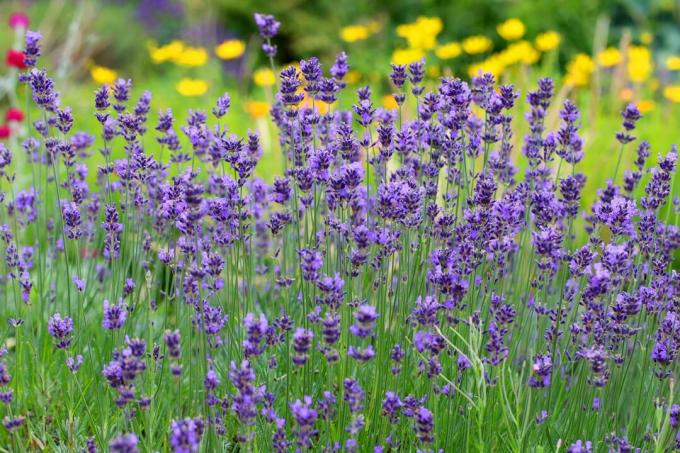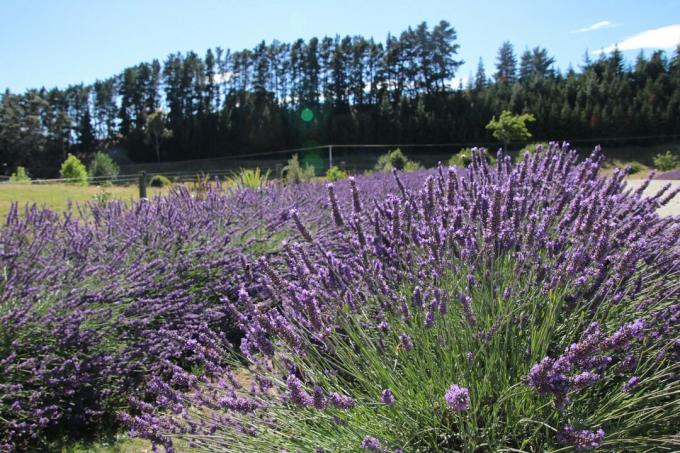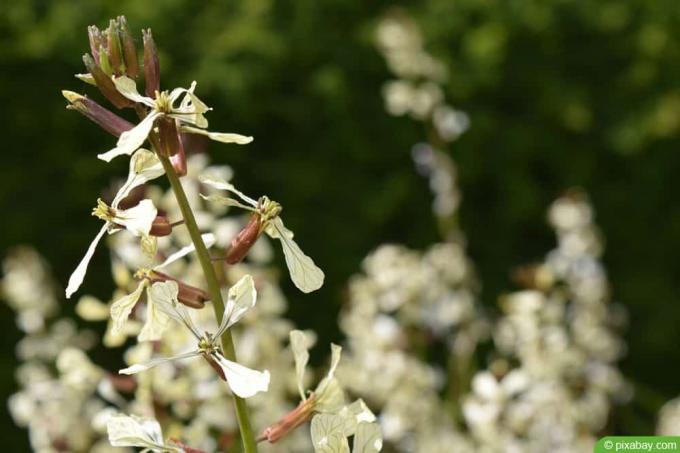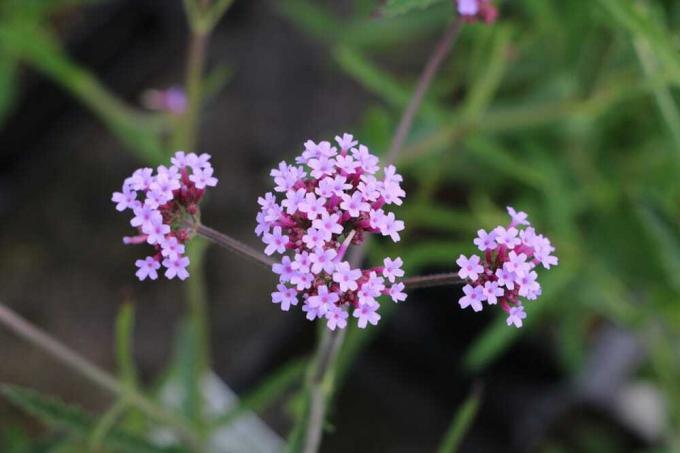

Table of contents
- Characteristics
- Location
- Plant
- tub culture
- transplant
- repot
- plant neighbors
- Pour
- Fertilize
- Cut
- heyday
- harvest time
- hibernate
- multiply
- sowing
- lowering
- diseases and pests
- root rot
- Phoma Lavandulae
Lavender, with its aromatic scent, is a welcome addition to any garden in this country. True lavender is quite hardy in our latitudes. With proper care and location, it grows into large bushes.
Characteristics
Real lavender originally came from (Lavandula angustifolia) from areas in the Mediterranean region. Due to the essential oils they contain, the easy-care subshrubs exude a very pleasant, sweet scent during the summer months. In addition to real lavender, there are now up to 30 other varieties of the popular aromatic and medicinal herb. However, these are not as hardy as Lavandula angustifolia. Typical of real lavender, on the other hand, are:
- Growth height 50 to 100 cm
- intense blue-violet flowers
- many individual flowers in spikes together
- tomentose, grey-green to silver-colored leaves
- to the mint family (Lamiaceae) belonging
- woody from below
- It copes well with drought and high temperatures
- undemanding in care
- also good for cultivation in pots
- good beginner plant
A notice:
Lavender regulates digestion and calms the nerves. As a bath additive, the herb regulates blood pressure and cares for the skin.
Location
Growing lavender is quite easy. However, for healthy growth, certain requirements must be met. So lavender makes some demands on its location. The subshrub originally comes from the dry areas of the Mediterranean region and grows there on rather poor and stony soil. In this country, too, Lavandula angustifolia needs similar conditions to thrive. He needs
- a sunny, dry and wind-protected place
- lean, well drained, calcareous to neutral soil
- prepare heavy soils with sand
A slightly sandy to stony plant substrate is ideal when cultivating the subshrub, because the drought-loving lavender does not tolerate waterlogging.
Plant

The uses of Lavandula angustifolia in the garden are quite diverse. It can easily be planted out in a bed, but it can also be cultivated in a tub or pot. This has the advantage that the lavender can also exude its aromatic scent in a wide variety of places such as balconies and terraces. This subshrub is also often used to create low hedges. Here three plants should be planted per running meter. When planting in open ground, the procedure is as follows:
- best time spring from mid-May
- Dig a planting hole
- twice the size of the root ball
- Place a drainage layer in the planting hole
- composed of pebbles and sand
- Plant in the middle
- fill in calcareous, loose soil
- press and pour well
- Planting distance must be at least 30 cm
- this allows good bushy growth
In the garden, the Lavandula angustifolia can also be easily integrated into a herb spiral. Here the subshrub should find its place in the upper third in a southern or western direction.
tub culture
Lavender also looks good in a suitably large bucket on the balcony or terrace. The following should be observed when cultivating these subshrubs:
- Pot must have drainage hole at bottom
- a coaster is also important
- Clay pots are well suited
- better evaporation of the water possible here
- Put a drainage layer in the pot
- consisting of pebbles, expanded clay or potsherds
- then apply a nutrient-poor, calcareous substrate layer
- preferably use herbal soil mixed with sand
- insert plant
- fill in the remaining soil
- press well and pour
transplant
If possible, Lavandula angustifolia should not be transplanted when grown outdoors. Over the years, it develops a widespread and deep network of roots. In an ideal location, it can live to be 15 years and older. However, if transplanting is necessary, proceed as follows:
- Loosen roots extensively and deeply with a digging fork
- then carefully dig out
- do not injure roots
- replant in another location
- best time March to May
repot

When growing in a tub or pot, repotting should take place annually if possible. The best time is March before the new shoots:
- choose a new bucket at least a third larger
- completely exchange the old substrate for a new one
- ideally one third compost mixed with coarse, calcareous sand
- Carefully loosen the root ball before re-inserting
- cut back roots if necessary
A notice:
The "Peter Pan" and "Nana Alba" varieties are particularly suitable for cultivation in tubs with real lavender. In addition, not so hardy varieties such as French lavender (Lavandula stoechas) or spike lavender (Lavandula latifolia) are recommended for cultivation in the bucket.
plant neighbors
In the bed or in the herb spiral, lavender naturally feels particularly at home among its peers. In other words, this includes other Mediterranean herbs that make exactly the same demands on location and soil as the subshrub. These include, among other things
- sage (salvia)
- thyme (thymus)
- rosemary (Rosmarinus officinalis) or
- mountain savory (Satureja montana)
Lavender is also often said to be a good companion for roses (Pink) is. He is here the aphid infestation on roses. reduce. However, you should avoid growing the subshrub in the immediate vicinity of roses, because the demands on the soil are too different here. In contrast to lavender, the queen of flowers prefers a humus-rich and nutrient-rich soil. Catnip is a better plant neighbor here (Nepeta cataria). However, lavender in the rose bed does not have to be completely dispensed with. However, this should then be planted at a minimum distance of 80 to 100 cm. Sand must then be filled into the planting hole.
Pour
When growing Lavandula angustifolia, care is of course always crucial for healthy growth. Lavender has a widespread root system with a long taproot. As a result, the subshrub is able to supply itself with nutrients and the required moisture from the deepest layers of the earth. Normally, Lavandula angustifolia only needs additional watering in the garden during longer periods of drought. The situation is different with bucket culture. A regular water supply is important here. However, the surface of the earth should be dry before each new watering.
In general, the procedure for casting is as follows:
- always give water only close to the ground
- Do not wet leaves and flowers
- otherwise fungal attack possible
- always water in the morning
- The plant can then dry well during the day
A notice: Lavender is not only pleasing to the eye, it also magically attracts beneficial insects such as bees, bumblebees and butterflies.
Fertilize
Fertilizing should not be forgotten when growing Lavandula angustifolia, but should be done carefully. The subshrub needs only a few nutrients. Over-fertilization through regular nutrient inputs would rather damage the semi-shrub. He would inevitably die. Some organic fertilizer or compost should be worked into the soil when planting. In such a case, basic fertilization is only necessary again in the following year in March / April. Fertilizer is only applied again at the beginning of summer for a culture in a bucket. When growing real lavender, however, a dose of garden lime in the spring is appropriate:
- spread a handful of lime around plants
- Work in lightly with a rake
- Soil pH should be between 6.5 and 8
- measurement necessary for this
Cut
Over time, the young shoots lignify from below. A pruning is therefore necessary to prevent baldness. One or two cuts should therefore be made every year:
- first pruning in spring shortly before new shoots in March/April
- cut back hard here
- Shorten the plant by at least one to two thirds
- second pruning after flowering July to early August
- only cut back a third on older plants
- in the case of younger plants, pruning up to half is possible
A notice:
No pruning should be done in autumn, otherwise severe frost damage can occur and flowering will not occur next year.
heyday
The flowering time always depends on the variety, the weather, the soil conditions and care. Lavandula angustifolia starts flowering in June to late July/early August. On the other hand, the first flowers of French lavender are already visible from May. A summer cut can stimulate renewed flowering.

harvest time
Lavender leaves and flowers are edible. They can be used in salads, soups or fish dishes. Harvest should take place shortly after the flowers open in May/June to August/September. Blossoms, leaves and young shoot tips are harvested.
hibernate
Lavandula angustifolia is hardy down to temperatures of -15°C. Nevertheless, a light winter protection should also be applied outdoors, precisely to prevent frost drying out:
- to do this, apply a layer of leaves or brushwood to the root disc
- possibly cover the plant with fleece or coconut mats
- Overwinter non-hardy varieties or container cultures in a bright, frost-free and cool place indoors
- if necessary, water plants on frost-free days
multiply
Propagation can be done by sowing, cuttings and cuttings. The latter method is the easiest and fastest:
- Take 15 cm long cuttings in spring or late summer
- strip off the bottom leaves
- then stick 10 cm deep in a mixture of sand and potting soil
- keep well moist
- solitary after rooting
- plant outdoors after the last frosts
sowing
- Preculture February to May on a windowsill
- Use of seed compost
- Press seeds lightly onto moist soil
- Plant is light germinator
- set up bright and warm
- keep well moist
- after 10 to 20 days the first seedlings appear
- separate if of sufficient size
- Direct sowing possible from May
lowering
- in the spring push the branch to the ground and remove the leaves
- draw a furrow underneath
- Introduce branch there and cover with soil
- fasten well with wire
- Root formation occurs by autumn
- then separate the young plant from the mother plant

diseases and pests
Due to the essential oils it contains, Lavandula angustifolia is rarely attacked by pests. However, there are also diseases that are feared here:
root rot
- particularly occurring in warm winters and when there is high humidity
- due to waterlogging, the roots die off
- thus no more water supply to the plant
- eventually dry up
- Remove or repot diseased plants
- Avoid waterlogging
Phoma Lavandulae
This is a fungal disease. Infection occurs via wounds and during the summer months it also occurs in young shoots in the leaf axils. The fungus spreads within the plants:
- Emergence of yellowish twigs in May
- Plant next to it covered with brown-black spots, especially leaves
- there formation of spherical fruiting bodies of the fungi
- eventually the affected parts of the plant die off
- Remove diseased plant parts immediately and dispose of them in the household waste
- maybe whole plant
 garden editorial
garden editorial I write about everything that interests me in my garden.
Learn more about garden herbs

Lady's mantle: 9 tips for planting, caring for and cutting
The lady's mantle can be found in almost every garden. There are around 1,000 different species. Here's the best time to plant it and how to care for it. it is also clarified whether and how it has to be cut.

Rosemary leaves have white spots: what to do?
Rosemary can be affected by white spots all year round. Before using home remedies, the problem should be investigated. If site conditions and care measures are optimal, diseases and pests can be the cause. Fungi require different control measures than harmful insects.

Rocket is blooming: is it still edible when blooming?
Rocket, also known as rocket, is a traditional cultivated plant that has been somewhat forgotten in recent years. It is now back in fashion and can be found in numerous dishes as a raw vegetable salad, side dish or herb.

Make your own mint tea – What is the effect of fresh mint tea?
Mint tea tastes best when you brew it from freshly picked mint leaves. In this way, the aromatic herb unfolds its healing effect against all kinds of ailments. However, there are also contraindications, because fresh mint tea can also have undesirable side effects.

Harvest peppermint when it blooms? | What to watch out for with mint
Due to its spicy flavor and easy-care properties, peppermint has become widespread in the local latitudes. Only the leaves need to be harvested for consumption. However, there are a number of factors to consider during the flowering period, as the flavor then changes significantly.

c: Profile | Caring for and harvesting verbena
Verbena has established itself as a popular plant in the local latitudes thanks to its strong growth potential and long-lasting flowering period. In addition to a distinctive appearance, the plant known as Verbena also has healing properties. This places certain demands on care and location.



